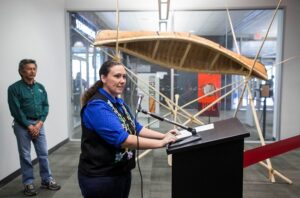Carleton University undertakes learning difficult truths about shared past by learning together

By Rick Garrick
OTTAWA — The importance of Institutional Humility and 41 specific Calls to Action to guide reconciliation, Indigenous learning efforts and positive long-term change were highlighted in Carleton University’s recently released Kinàmàgawin (learning together), the final report published by the Carleton University Strategic Indigenous Initiatives Committee (CUSIIC).
“One of the things we talk about in the report is this concept of Institutional Humility,” says Benny Michaud, assistant director of the Department of Equity and Inclusive Communities and co-chair of the CUSIIC. “In order to begin any type of reconciliation work within a post-secondary institution, you have to recognize the part that educational institutions in Canada have played historically in oppressing our people and in hurting our communities, and until you can acknowledge that, you can’t begin to do things differently.”
The 41 Calls to Action, which are aimed at making Carleton a safer and more welcoming space for current and future Indigenous students and faculty members, span seven themes: community engagement; Indigenous student support; student experience; ways of teaching and learning; culture, systems and structure; research and innovation; and metrics.
“We’ve committed to providing a report annually that will provide an overview to communities external from Carleton and internally with information around what we’ve accomplished,” Michaud says. “Some of the Calls to Action are long-term goals and some of them are goals that can be completed in the intermediate to short-term. So letting people know this is an ongoing priority, certainly for the Centre for Indigenous Initiatives and also for senior administration, is important.”
Michaud says Carleton had been working towards bringing Indigenous pedagogies into the university for decades, but the release of the Truth and Reconciliation Commission’s Final Report and Calls to Action in 2015 led to the creation of the strategy.
“Carleton wanted to officially respond to those Calls to Action by creating a comprehensive strategy for the entire university that would look at what we could do as an institution to further support Indigenous students in their academic success and in their health and well-being,” Michaud says. “And then also how can we increase awareness around the lived experiences of Indigenous people in Canada among our faculty, staff and students.”
Michaud says the process began after president Benoit-Antoine Bacon was installed at Carleton in 2018. He says in the report that the only way to make any progress is to meet each other as human beings, to listen in order to understand rather than to convince and to consider the consequences that one’s actions or inaction will have seven generations into the future.
“The very first thing he did was he brought together Indigenous faculty and staff and asked us, ‘What is it you think we need here at the university?’” Michaud recalls. “And our response overwhelmingly was that we need a strategy that is for the entire university.”
The strategy was developed by CUSIIC, led by co-chairs Michaud, Kahente Horn-Miller, professor in the School of Indigenous and Canadian Studies at Carleton, and Jerry Tomberlin, provost and vice-president (academic) at Carleton, over an 18-month consultation process involving more than 40 consultation sessions with more than 600 participants, including faculty, staff, students and First Nations, Métis and Inuit communities.
“The full [CUSIIC] committee consisted of 35 different people who saw us through this process and provided insight along the way,” Michaud says. “They believed that in order to do this work, we needed to acknowledge that historic relationship between academic institutions and Indigenous communities.”
The Kinàmàgawin report is available online.


